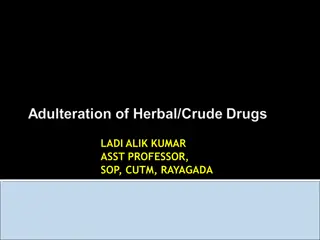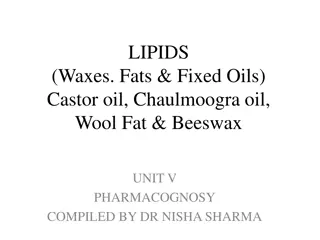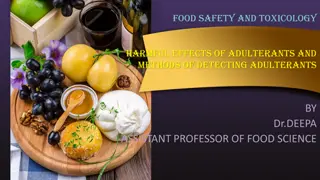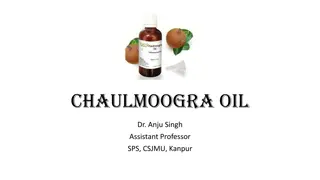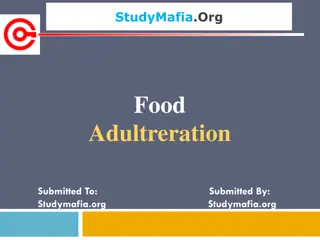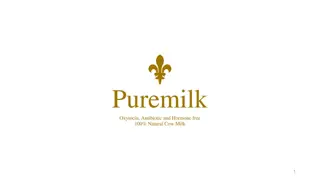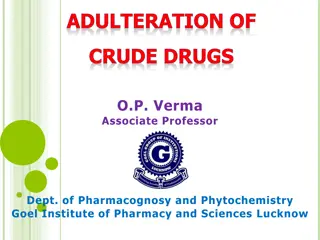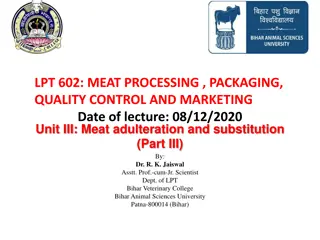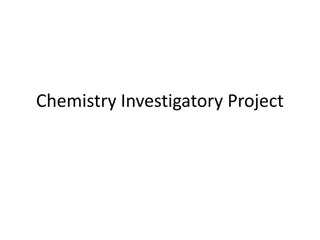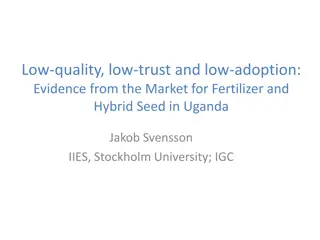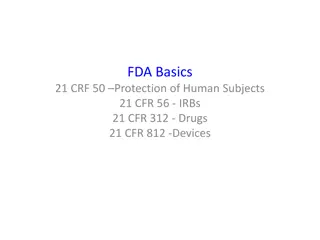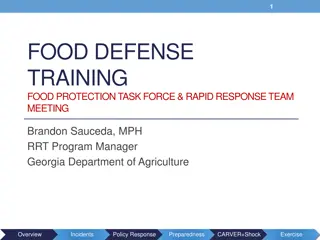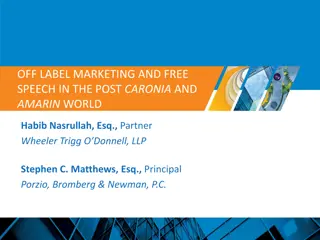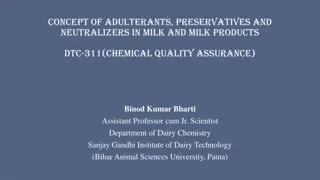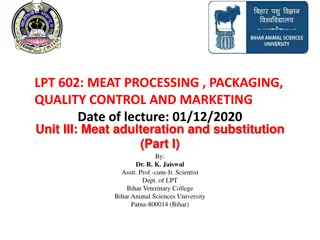Understanding Adulteration in Drugs and Food Industry
Adulteration is the deceptive practice of substituting original substances with inferior or harmful ones. Deliberate and accidental adulteration can lead to health risks and financial gains. Different types of adulterants, reasons for adulteration, and ways to prevent it are discussed in this inform
1 views • 34 slides
Understanding Lipids: Waxes, Fats, and Fixed Oils
Lipids are organic compounds like waxes, fats, and fixed oils found in plants and animals. Fixed oils are reserve food materials, while fats are solid at higher temperatures. These substances are esters of glycerol and fatty acids, with various components giving them unique properties and flavors. C
0 views • 20 slides
Food Safety and Toxicology: Adulterants and Detection Methods
Food adulteration can have harmful effects on health by altering the natural composition of food. Learn about the risks of adulterants, their effects, and methods for detecting them in food products. Ensuring food safety is crucial to prevent toxic compounds and nutrient deficiencies that can impact
0 views • 15 slides
Comprehensive Guide to Chaulmoogra Oil: Properties, Sources, and Uses
Chaulmoogra oil, a yellow to brownish-yellow liquid, is extracted from the seeds of the Hydnocarpus plant. This oil contains chaulmoogric acid and hydnocarpic acid, making it valuable in traditional medicine. The oil is prepared by cold expression and has various chemical constituents. It is primari
0 views • 10 slides
Understanding Food Adulteration: Causes, Methods, and Prevention
Food adulteration is the deceptive practice of adding substandard or harmful substances to food products for economic gain. This unethical practice reduces the nutritional value of food and poses serious health risks to consumers. Causes include business strategies and lack of proper food knowledge,
1 views • 15 slides
Understanding Quality Control of Drugs of Natural Origin
This chapter delves into the various methods of detecting adulteration in crude drugs, with examples and evaluation techniques to preserve their quality. It discusses deliberate and unintended forms of adulteration, their detection methods, and reasons behind deliberate adulteration. The content emp
3 views • 12 slides
The Dark Reality of Milk Industry Adulteration in Kolkata
A shocking exposé reveals the grave dangers lurking in Kolkata's milk industry - cows injected with illegal drugs, contaminated feed and water, and mafia operations. Milk available in the market is tainted with fatal adulterants like oxytocin, antibiotics, and growth hormones, posing serious health
0 views • 26 slides
Understanding Adulteration of Crude Drugs
Adulteration of crude drugs involves substituting the original substance with similar-looking but chemically inferior ones. This deceptive practice can be intentional or accidental, driven by factors like profits, scarcity, or high prices in the market. Different types and reasons for adulteration a
0 views • 36 slides
Understanding Meat Adulteration: Chemical Methods for Detection
Explore the chemical methods used in meat processing to detect adulteration, including tests for glycogen content, linoleic acid levels, iodine value, refractive index, and myoglobin content in different animal species. Learn how these tests help identify potential adulteration and ensure meat quali
0 views • 7 slides
Investigation on Detection of Food Adulteration in Chemistry
This chemistry investigatory project focuses on detecting food adulteration through various experiments. Experiment-1 aims to detect adulterants in fat, oil, and butter, while Experiment-2 investigates adulteration in sugar. Experiment-3 aims to detect adulterants in chili powder, turmeric powder, a
0 views • 18 slides
Addressing Low Adoption of Modern Agricultural Technologies in Uganda
Market failures are hindering the adoption of high-yielding seed varieties and fertilizers by smallholder farmers in Uganda. Research suggests various constraints such as lack of information, credit, and insurance. A hypothesis is proposed, questioning if the technologies are not adopted due to adul
0 views • 35 slides
Understanding FDA Regulations in Clinical Research
FDA regulations in clinical research cover the protection of human subjects, IND/IDE requirements, risk determinations, application processes, and what falls under FDA regulation. It distinguishes between FDA-regulated activities and those not regulated, such as medical record reviews. The scope inc
0 views • 31 slides
Food Defense Training and Rapid Response Team Meeting Overview
Food Defense Training and Rapid Response Team Meeting provides insights into food security, food defense, and food safety to protect against intentional and unintentional contamination incidents. The presentation delves into incidents, policies, responses, and preparedness, emphasizing the importanc
0 views • 24 slides
Off-Label Marketing and Free Speech in the Post Caronia and Amarin World
Background of off-label use and prohibition, First Amendment challenges to FDA authority, next steps for industry and FDA in responding to the new legal landscape. FD&C Act prohibits misleading labeling, FDA's regulatory authority on drug and device promotions, FDA's view on off-label promotion proh
0 views • 19 slides
Understanding Adulterants, Preservatives, and Neutralizers in Milk and Milk Products
Adulteration in milk involves adding cheaper substances or removing valuable constituents to make extra profit. Common adulterants include carbohydrates, salts, neutralizers, preservatives, detergents, and oils. Preservatives like hydrogen peroxide and formalin are used to prolong shelf life. Neutra
0 views • 13 slides
Understanding Meat Adulteration and Substitution in Food Processing
In meat processing, there is a risk of substituting lower quality meats for higher quality ones to deceive consumers. Differentiating between animal meats is crucial, especially in minced or sausage forms. Horseflesh, with its high glycogen content, presents a unique challenge. Methods for meat spec
0 views • 7 slides
